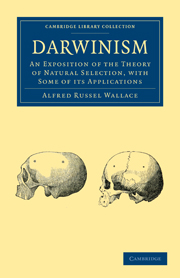Book contents
- Frontmatter
- Preface
- Contents
- LIST OF ILLUSTRATIONS
- CHAPTER I WHAT ARE “SPECIES” AND WHAT IS MEANT BY THEIR “ORIGIN”
- CHAPTER II THE STRUGGLE FOR EXISTENCE
- CHAPTER III THE VARIABILITY OF SPECIES IN A STATE OF NATURE
- CHAPTER IV VARIATION OF DOMESTICATED ANIMALS AND CULTIVATED PLANTS
- CHAPTER V NATURAL SELECTION BY VARIATION AND SURVIVAL OF THE FITTEST
- CHAPTER VI DIFFICULTIES AND OBJECTIONS
- CHAPTER VII ON THE INFERTILITY OF CROSSES BETWEEN DISTINCT SPECIES AND THE USUAL STERILITY OF THEIR HYBRID OFFSPRING
- CHAPTER VIII THE ORIGIN AND USES OF COLOUR IN ANIMALS
- CHAPTER IX WARNING COLORATION AND MIMICRY
- CHAPTER X COLOURS AND ORNAMENTS CHARACTERISTIC OF SEX
- CHAPTER XI THE SPECIAL COLOURS OF PLANTS: THEIR ORIGIN AND PURPOSE
- CHAPTER XII THE GEOGRAPHICAL DISTRIBUTION OF ORGANISMS
- CHAPTER XIII THE GEOLOGICAL EVIDENCES OF EVOLUTION
- CHAPTER XIV FUNDAMENTAL PROBLEMS IN RELATION TO VARIATION AND HEREDITY
- CHAPTER XV DARWINISM APPLIED TO MAN
- INDEX
CHAPTER VII - ON THE INFERTILITY OF CROSSES BETWEEN DISTINCT SPECIES AND THE USUAL STERILITY OF THEIR HYBRID OFFSPRING
Published online by Cambridge University Press: 29 August 2010
- Frontmatter
- Preface
- Contents
- LIST OF ILLUSTRATIONS
- CHAPTER I WHAT ARE “SPECIES” AND WHAT IS MEANT BY THEIR “ORIGIN”
- CHAPTER II THE STRUGGLE FOR EXISTENCE
- CHAPTER III THE VARIABILITY OF SPECIES IN A STATE OF NATURE
- CHAPTER IV VARIATION OF DOMESTICATED ANIMALS AND CULTIVATED PLANTS
- CHAPTER V NATURAL SELECTION BY VARIATION AND SURVIVAL OF THE FITTEST
- CHAPTER VI DIFFICULTIES AND OBJECTIONS
- CHAPTER VII ON THE INFERTILITY OF CROSSES BETWEEN DISTINCT SPECIES AND THE USUAL STERILITY OF THEIR HYBRID OFFSPRING
- CHAPTER VIII THE ORIGIN AND USES OF COLOUR IN ANIMALS
- CHAPTER IX WARNING COLORATION AND MIMICRY
- CHAPTER X COLOURS AND ORNAMENTS CHARACTERISTIC OF SEX
- CHAPTER XI THE SPECIAL COLOURS OF PLANTS: THEIR ORIGIN AND PURPOSE
- CHAPTER XII THE GEOGRAPHICAL DISTRIBUTION OF ORGANISMS
- CHAPTER XIII THE GEOLOGICAL EVIDENCES OF EVOLUTION
- CHAPTER XIV FUNDAMENTAL PROBLEMS IN RELATION TO VARIATION AND HEREDITY
- CHAPTER XV DARWINISM APPLIED TO MAN
- INDEX
Summary
One of the greatest, or perhaps we may say the greatest, of all the difficulties in the way of accepting the theory of natural selection as a complete explanation of the origin of species, has been the remarkable difference between varieties and species in respect of fertility when crossed. Generally speaking, it may be said that the varieties of any one species, however different they may be in external appearance, are perfectly fertile when crossed, and their mongrel offspring are equally fertile when bred among themselves; while distinct species, on the other hand, however closely they may resemble each other externally, are usually infertile when crossed, and their hybrid offspring absolutely sterile. This used to be considered a fixed law of nature, constituting the absolute test and criterion of a species as distinct from a variety; and so long as it was believed that species were separate creations, or at all events had an origin quite distinct from that of varieties, this law could have no exceptions, because, if any two species had been found to be fertile when crossed and their hybrid offspring to be also fertile, this fact would have been held to prove them to be not species but varieties. On the other hand, if two varieties had been found to be infertile, or their mongrel offspring to be sterile, then it would have been said: These are not varieties but true species. Thus the old theory led to inevitable reasoning in a circle; and what might be only a rather common fact was elevated into a law which had no exceptions.
- Type
- Chapter
- Information
- DarwinismAn Exposition of the Theory of Natural Selection, with some of its Applications, pp. 152 - 186Publisher: Cambridge University PressPrint publication year: 2009First published in: 1889



